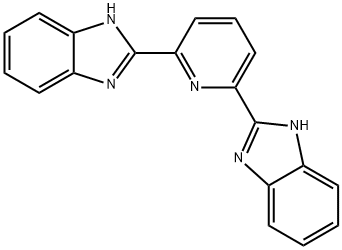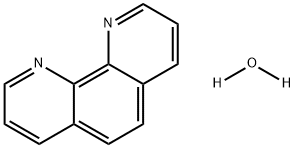A1383812
2,6-Bis(2-benzimidazolyl)pyridine , 98% , 28020-73-7
CAS NO.:28020-73-7
Empirical Formula: C19H13N5
Molecular Weight: 311.34
MDL number: MFCD00134500
EINECS: 624-875-9
| Pack Size | Price | Stock | Quantity |
| 1G | RMB212.00 | In Stock |
|
| 5G | RMB503.20 | In Stock |
|
| 25g | RMB2317.60 | In Stock |
|
| others | Enquire |
Update time: 2022-07-08
PRODUCT Properties
| Melting point: | >300 °C(lit.) |
| Boiling point: | 664.0±65.0 °C(Predicted) |
| Density | 1.386±0.06 g/cm3(Predicted) |
| storage temp. | 2-8°C |
| pka | 10.36±0.10(Predicted) |
| form | powder to crystal |
| color | White to Almost white |
| λmax | 325nm(CH3CN)(lit.) |
| InChI | InChI=1S/C19H13N5/c1-2-7-13-12(6-1)21-18(22-13)16-10-5-11-17(20-16)19-23-14-8-3-4-9-15(14)24-19/h1-11H,(H,21,22)(H,23,24) |
| InChIKey | JBKICBDXAZNSKA-UHFFFAOYSA-N |
| SMILES | C1(C2NC3=CC=CC=C3N=2)=NC(C2NC3=CC=CC=C3N=2)=CC=C1 |
Description and Uses
2,6-Bis(2-benzimidazolyl)pyridine may be employed as a chemosensor for the detection of fluoride ions. It may be used as a sensor for the detection of toxic metabolites of benzene such as phenol, hydroquinone, resorcinol, catechol and p-benzoquinone.
Safety
| Symbol(GHS) |  GHS07 |
| Signal word | Warning |
| Hazard statements | H315-H319-H335 |
| Precautionary statements | P261-P264-P271-P280-P302+P352-P305+P351+P338 |
| Hazard Codes | Xi |
| Risk Statements | 36/37/38 |
| Safety Statements | 26-37/39 |
| WGK Germany | 3 |
| HazardClass | IRRITANT |
| HS Code | 29333990 |




